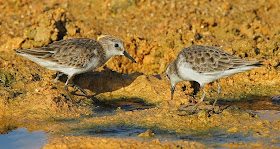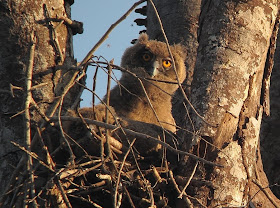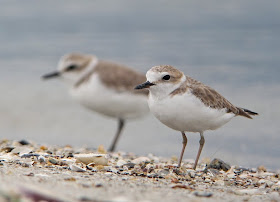A visit from friends Peter Harris and Mel Ong of A Rocha (check out
the website - they're doing some GREAT work around the world) gave me the excuse to take a couple of days out showing them around the famous sites of Penang, which include a landfill site (oh - I meant famous BIRDING sites!).
The usual birds were on their best behaviour, giving point blank views and photo opps in the golden early morning light. I mostly just enjoyed the scene, but occasionally deigned to point the camera in the direction of a bird.
 A Wood Sandpiper posing in front of a blue studio backdrop (actually a metal fence).
A Wood Sandpiper posing in front of a blue studio backdrop (actually a metal fence). A Paddyfield Pipit giving 'field guide views'in front of the same backdrop.
A Paddyfield Pipit giving 'field guide views'in front of the same backdrop. A Purple Heron contemplating the mysteries of life (in front of an actual blue sky).
A Purple Heron contemplating the mysteries of life (in front of an actual blue sky). A Blue-tailed Bee-eater in a typically photogenic pose.
A Blue-tailed Bee-eater in a typically photogenic pose.
While my friends were purring over these sumptuous delights, I was feeling pretty relaxed about everything, until I noticed a smaller duck among a flock of flying whistling-ducks...
 Casting off my laid-back smugness, I sprang into action!...An eclipse male Garganey - long-awaited and much-looked for, my 559th species for Peninsular Malaysia.
Casting off my laid-back smugness, I sprang into action!...An eclipse male Garganey - long-awaited and much-looked for, my 559th species for Peninsular Malaysia. It landed distantly, and before I could set up the digiscoping gear, had secreted itself in thick vegetation, not to be seen again that day (but it has behaved better since, see Muin's blog).
It landed distantly, and before I could set up the digiscoping gear, had secreted itself in thick vegetation, not to be seen again that day (but it has behaved better since, see Muin's blog).Much closer at hand was a nice selection of waders and wagtails in some muddy pools next to the road.

 Some Eastern Yellow Wagtails...
Some Eastern Yellow Wagtails... ...Little Ringed Plovers...
...Little Ringed Plovers...and stints...






 Long-toed Stints - they're such beauties I'm not going to apologize for OD'ing on these!And then, four other stints, which, much to the disappointment of Peter (from the UK), turned out to be ALL Little Stints! I tried to explain that these are really rare here compared to Red-necked, which is by far the commonest calidrid, normally, but this didn't seem to cheer him up much!
Long-toed Stints - they're such beauties I'm not going to apologize for OD'ing on these!And then, four other stints, which, much to the disappointment of Peter (from the UK), turned out to be ALL Little Stints! I tried to explain that these are really rare here compared to Red-necked, which is by far the commonest calidrid, normally, but this didn't seem to cheer him up much! Two Little Stints with a Long-toed (bottom left).
Two Little Stints with a Long-toed (bottom left). Why are these Little rather than Red-necked? It's a combination of features rather than one stand-out.
Why are these Little rather than Red-necked? It's a combination of features rather than one stand-out. Firstly, the 'bare parts'. The legs are long, both below and above the joint, but especially above (the tibia). (The legs are dark by the way - the yellowish colouration is due to the mud). The bill is finer and slighter than on Red-necked, both at the base and the tip.
Firstly, the 'bare parts'. The legs are long, both below and above the joint, but especially above (the tibia). (The legs are dark by the way - the yellowish colouration is due to the mud). The bill is finer and slighter than on Red-necked, both at the base and the tip. They have a distinctive 'round-shouldered' shape when feeding, the legs are usually well bent and the tail-end tends to be slightly angled upward.
They have a distinctive 'round-shouldered' shape when feeding, the legs are usually well bent and the tail-end tends to be slightly angled upward. The head and neck of Little Stint (LS) are subtly different from Red-necked Stint's (RNS) - smaller, narrower head-on, and with more 'neck'. The back of the head (rear crown-nape area) often seems to slope away rather than being strongly angled (as it often looks on RNS).
The head and neck of Little Stint (LS) are subtly different from Red-necked Stint's (RNS) - smaller, narrower head-on, and with more 'neck'. The back of the head (rear crown-nape area) often seems to slope away rather than being strongly angled (as it often looks on RNS). The head seems to be 'stuck on' the top of the body, while on Red-necked it seems stuck on the front (I guess this means that LS tends to stand more upright, while RNS has a rather horizontal stance usually). The body itself is rounder on LS (especially in the chest area) and more slender on RNS.
The head seems to be 'stuck on' the top of the body, while on Red-necked it seems stuck on the front (I guess this means that LS tends to stand more upright, while RNS has a rather horizontal stance usually). The body itself is rounder on LS (especially in the chest area) and more slender on RNS. Plumage-wise, there's not much to go on in adult non-breeding plumage. Most LS have rather dark-centred upperpart feathers in fresh plumage (with whitish tips on very fresh feathers), whereas most RNS have much plainer and paler upperpart feathers. One of the four (seen left here) was clearly more worn than the others, and was distinctly brownish above.
Plumage-wise, there's not much to go on in adult non-breeding plumage. Most LS have rather dark-centred upperpart feathers in fresh plumage (with whitish tips on very fresh feathers), whereas most RNS have much plainer and paler upperpart feathers. One of the four (seen left here) was clearly more worn than the others, and was distinctly brownish above.


 Some more shots showing the typically 'hunch-backed' appearance.
Some more shots showing the typically 'hunch-backed' appearance.Some of the differences I've mentioned above are easier to assess on still photos than on fast-moving birds. Anyone interested in this tricky pair of stints should make the most of this opportunity to familiarize yourself with Little Stints (at least if you live in Malaysia!). They seem to be hanging around.

 A late morning visit to Kampung Permatang Nibong yielded three Great Spotted Eagles (two of which are shown above).
A late morning visit to Kampung Permatang Nibong yielded three Great Spotted Eagles (two of which are shown above).





























































